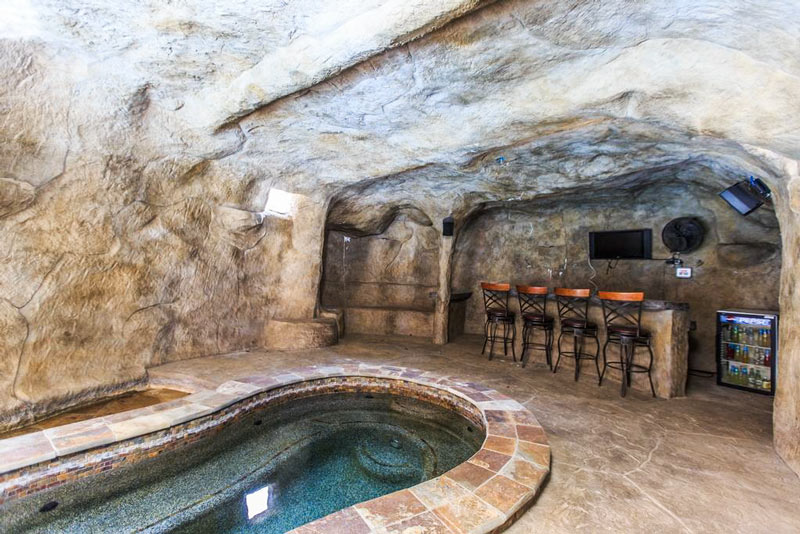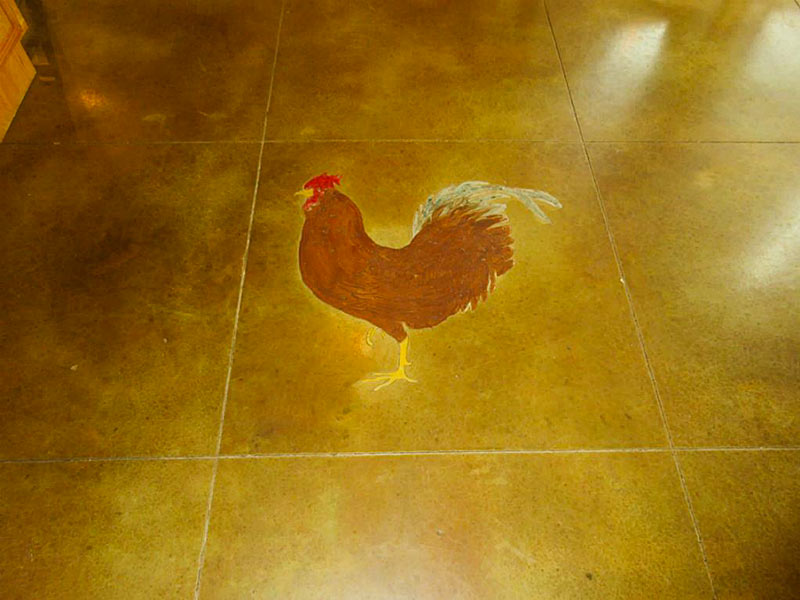
- 2355 Dutton Lane [HAR]

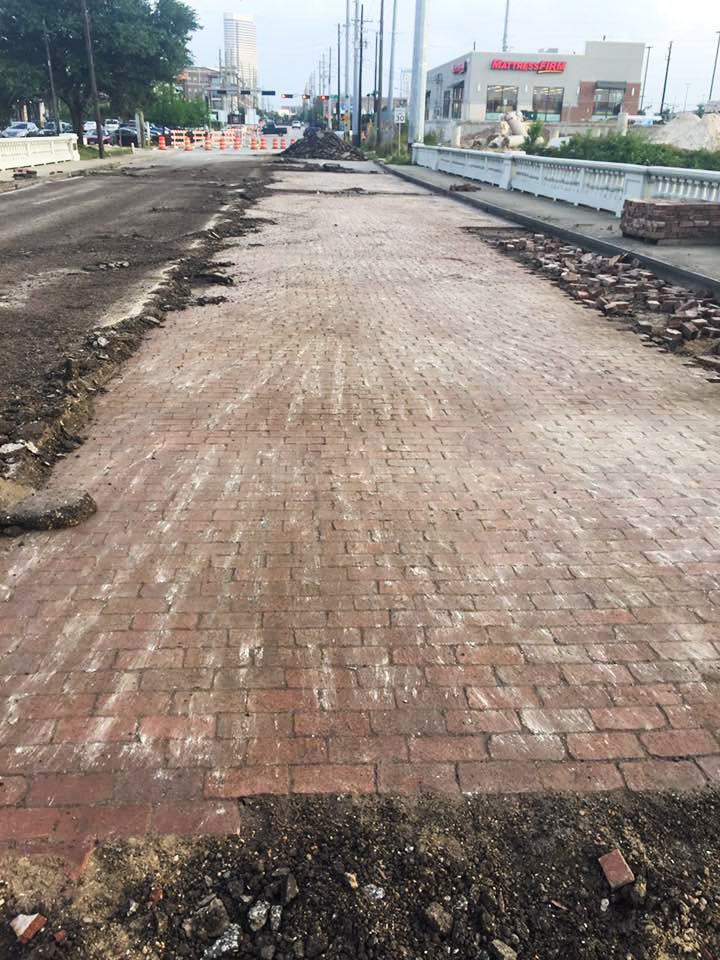
An indiegogo page has just been launched to crowdfund the removal and reuse of an unexpectedly large group of well-preserved 1930s bricks from the now-under-deconstruction Yale St. bridge over White Oak Bayou. The group calling itself Friends of Houston’s Yale Bridge Bricks says the funds will be used to preserve the bricks for reuse both around the bridge and elsewhere around the city.
The fundraising effort shares some organizers with Friends of the Fountain, which launched the late-February campaign to crowdfund the de-restoration and subsequent repair of the Mecom Fountain following its short-lived experiment with limestone couture. That effort raised more than $50,000 toward a $60k goal in one month; Bill Baldwin (of both Friends groups) says it the fountain’s fundraiser received over $100k in total, including offline donations. This latest round of online crowdfunding the preservation of National Register of Historic Places structures is starting the bar higher, with a goal of $100,000 shown on the fundraising page.
Photo of work on Yale St. Bridge and Memorial Park Mattress Firm: Friends of Houston’s Yale Bridge Bricks
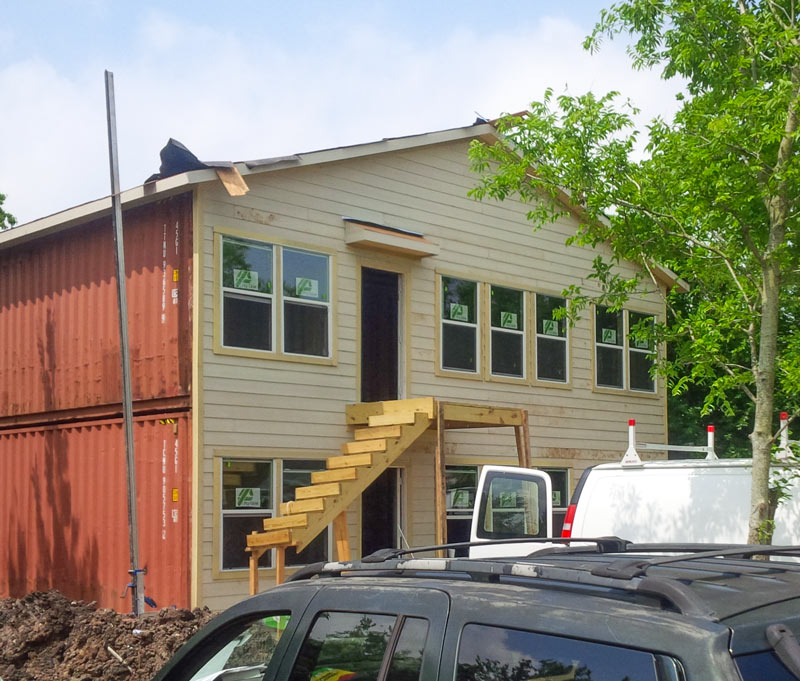
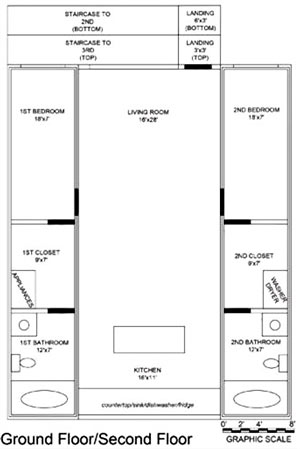 The front is up on the shipping-container-containing duplex under construction now at 3622 Lehall St. between Tierwester and Scott. The box-based structure is similar to builder Krieger Containers’s first such project (down the street at 3802 Lehall); both buildings consist of 2 separate 2-bed 2-bath units framed around 2 steel containers each. The company claims on its website that the model can beat ‘any general contractor in Houston’ on a cost-per-sq.-ft. basis.
The front is up on the shipping-container-containing duplex under construction now at 3622 Lehall St. between Tierwester and Scott. The box-based structure is similar to builder Krieger Containers’s first such project (down the street at 3802 Lehall); both buildings consist of 2 separate 2-bed 2-bath units framed around 2 steel containers each. The company claims on its website that the model can beat ‘any general contractor in Houston’ on a cost-per-sq.-ft. basis.
Back in September, company founder and steel box aficionado Sean Krieger spoke with Nancy Sarnoff about plans to built dozens more container houses in the South Union neighborhood over the next few years, aiming to draw students and young professionals. Krieger now tells ABC13 that the project underway at 3622 Lehall has faced abnormal scrutiny from city inspectors and officials, recently including a heated verbal exchange on site with District D councilman Dwight Boykins (who also spoke to ABC13 about the incident after Krieger sent them a recording).
The floorplan above shows the layout of the downstairs unit of completed 3802 Lehall; the bathrooms, bedrooms, and closets fit within the footprint of the shipping containers, which flank a central living space. Here are some shots of the inside, both during and after construction:
CITY RESPONSES TO UBER THREATS CITE BACKGROUND CHECK CATCHES, DATA UBER SUED TO KEEP PRIVATE 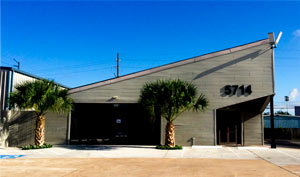 Mayor Turner held a press conference this week in response to Uber’s current PR push regarding Houston’s licensing requirements on Uber drivers. The rideshare company and ubiquitous favorite ‘[blank] of [industry]’ fill-in is threatening to pull out of Houston over the city’s rule that drivers must pass more stringent (specifically, more fingerprint-requiring) background checks than what Uber internally requires. Turner says the city’s checks have turned up criminal history in applicants already OK’d by Uber’s screening processes, including charges for DWI, assault, and murder. Meanwhile, city administrator Lara Cottingham tells Michael Barajas that Uber’s claims of drivers waiting 4 months for city licenses are exaggerated; the actual normal wait is a few weeks, Cottingham says, but the city can’t release data to support that because Uber sued in 2015 to block open records requests regarding its business practices. “The number of drivers is increasing, their revenue is increasing, everything seems to be working out for them very, very well,†said Cottingham, adding that because of the lawsuit she “can’t tell you how successful they are.” Uber lobbied last legislative season for less-stringent state-level licensing rules that would supercede local regulations. [KHOU, Houston Press; previously on Swamplot] Photo of Houston Uber HQ, 5714 Star Ln.: Uber Houston
Mayor Turner held a press conference this week in response to Uber’s current PR push regarding Houston’s licensing requirements on Uber drivers. The rideshare company and ubiquitous favorite ‘[blank] of [industry]’ fill-in is threatening to pull out of Houston over the city’s rule that drivers must pass more stringent (specifically, more fingerprint-requiring) background checks than what Uber internally requires. Turner says the city’s checks have turned up criminal history in applicants already OK’d by Uber’s screening processes, including charges for DWI, assault, and murder. Meanwhile, city administrator Lara Cottingham tells Michael Barajas that Uber’s claims of drivers waiting 4 months for city licenses are exaggerated; the actual normal wait is a few weeks, Cottingham says, but the city can’t release data to support that because Uber sued in 2015 to block open records requests regarding its business practices. “The number of drivers is increasing, their revenue is increasing, everything seems to be working out for them very, very well,†said Cottingham, adding that because of the lawsuit she “can’t tell you how successful they are.” Uber lobbied last legislative season for less-stringent state-level licensing rules that would supercede local regulations. [KHOU, Houston Press; previously on Swamplot] Photo of Houston Uber HQ, 5714 Star Ln.: Uber Houston
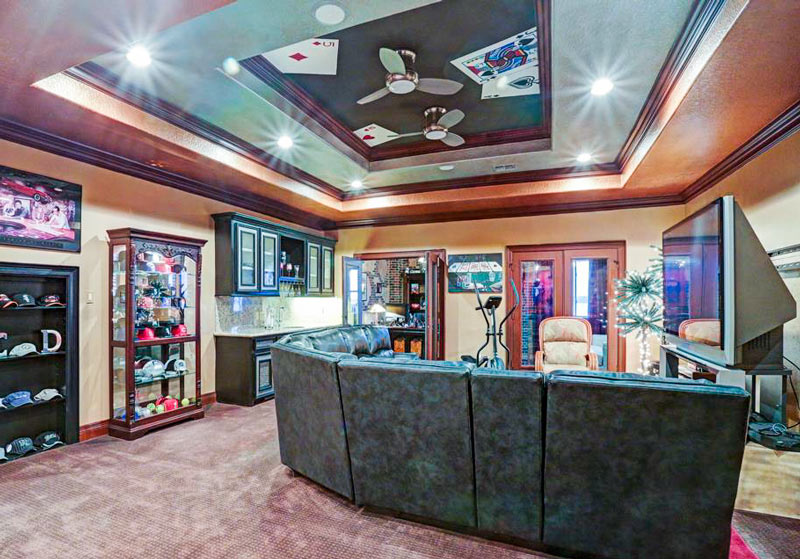
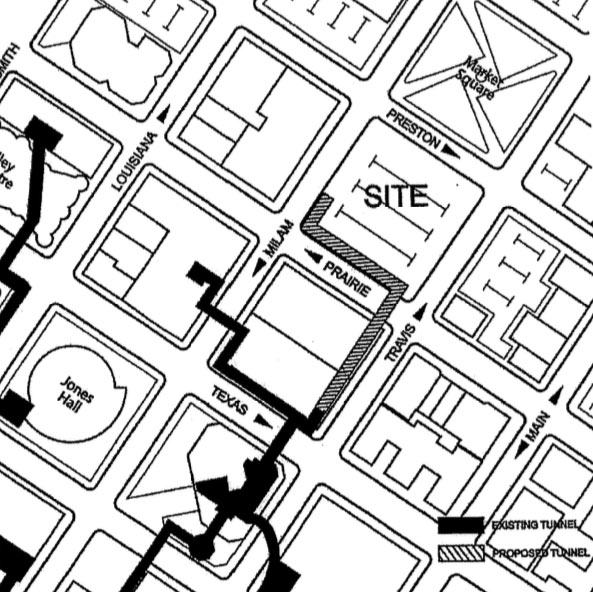
What led up to the neighborly lawsuit filed last week over the former Houston Chronicle building’s planned demolition? A pair of letters filed with the county clerk’s office as part of the suit sheds a little light on the back-and-forth between the building’s new owners and their new neighbors. Plaintiff Theater Square, a partnership controlled by construction and development firm Linbeck, is developing the downtown block marked SITE in the map above, immediately across Prairie St. from the former Chronicle property (bought last year by Hines entity Block 58 Investors). Theater Square wants to link its own could-be-a-Class-A-contender block into the Downtown tunnel network (traced above in solid black).
The company sued both Hines and Chronicle owner Hearst News last week to stop the demo, claiming that Hearst gave it property rights to build a new tunnel through the newspaper building’s basement (via the route shown in stripes above along Travis St.) and that the demo (as currently intended) interferes with that plan. Theater Square sent a letter to Hines on April 15th citing news stories about the impending demo and requesting both access to inspect the basement and assurances that the demolition would be carried out in a way that doesn’t harm certain existing structures that the new tunnel’s already-semi-permitted building plans depend on.

The original Shepherd-side location of 59 Diner is now up for lease, with teal-and-bubblegum exterior still intact. The whole 59 chain shut down suddenly at the end of February, amid a tangle of formal and informal disputes regarding employee pay. The listing indicates that the 6,000-sq.-ft. building (officially located at 3801 Farnham St.) can be divided, as long as the future tenant wants at least 2,000 ft.
The ex-diner property is next door to the smaller building now housing The Halal Guys, whose red-and-yellow striped canopy is visible on the right in the east-facing photo above. The former carwash reopened as the New-York-food-cart-gone-international-chain’s first Texas location a few weeks before the 59 closures; hundreds of customers lined up outside the tiny venue during the opening weekend rush, some allegedly filling 59’s parking lot while waiting for hours for gyros and chicken.
Photo: LoopNet
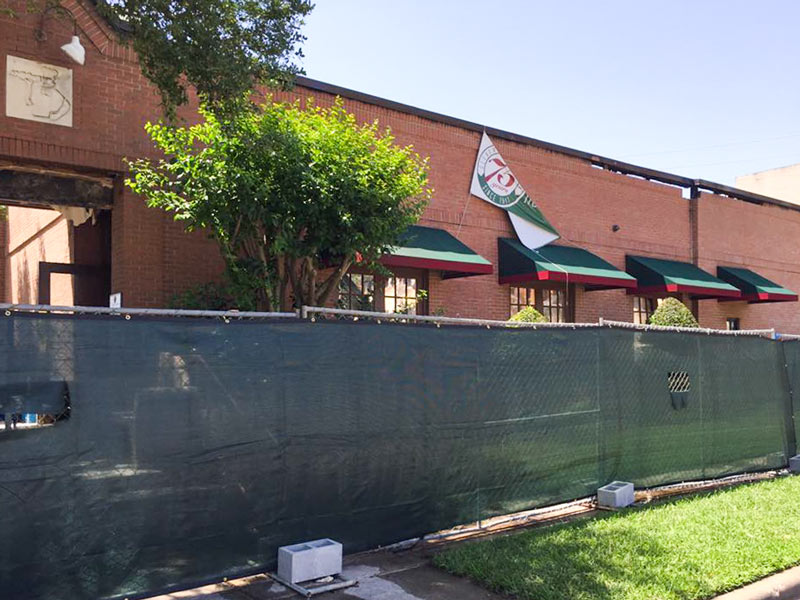
Construction fencing is already up around the Cleburne Cafeteria, which burned down for the second time at 3606 Bissonnet St. earlier this week. The 75-year-old cafeteria business was bought by Nick and Pat Mickelis in 1952 at its original location on Cleburne and Fannin streets (which was recently occupied by DiverseWorks for a brief pre-MATCH stint, and currently houses the Zoya Tommy art gallery). The cafeteria moved to the Bissonnet spot in 1969; shortly after Nick Mickelis’s death in 1989, the building burned down for the first time.
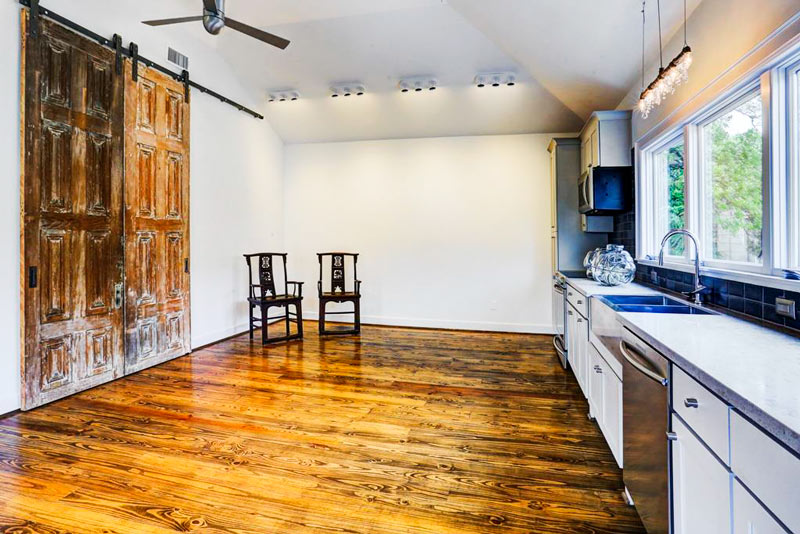
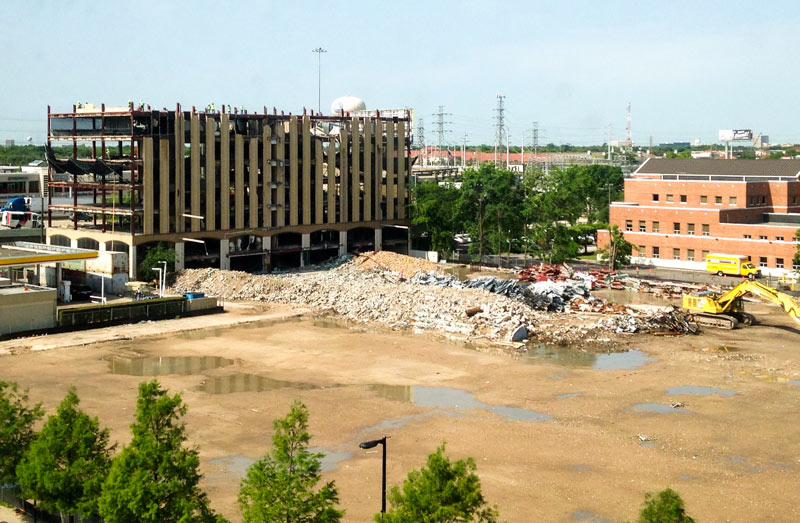
That’s 2 stories down and 8 left to go for the last holdout in the former Corporate Plaza office park, seen here from the northeast looking across Kirby Dr. toward 59. The freeway-facing and side facades of the once-10-story midrise have been totally removed, and the remaining facade is beginning to look a bit patchy around the top; piles of debris can be seen stretching out to the north of the structure, across the now-barren Upper Kirby plain where the partially demolished Corporate Plaza parking garage nearly demolished part of the demo team back in February.
Photo: Lulu
All the little red dots above show storefront retail locations throughout the Houston area. The map comes from Portland-based City Observatory, which just released a shiny new report on using the number and arrangement of customer-facing businesses to guide city planning. The bar in the top left corner lets you jump around between Houston and the 50 other cities mapped by the project.
Like the other studied towns, Houston is shown with a black ring marking off a 3-mile radius around Downtown. A closer look at Downtown shows a sharp divide in storefront density across the Main St. corridor:Â
CONTINUE READING THIS STORY
COMMENT OF THE DAY: STRIKING AT OTHER ROOTS OF HOUSTON FLOODING  “St. Augustine grass has a very shallow root system that barely reaches 2 inches into the soil. Beneath that root system is our typical thick clay gumbo soil that is very slow to drain moisture and more prone to let water run off into the storm sewer system. When you plant native grasses and plants, the roots reach down much deeper in the soil and fundamentally change the [bulk] composition of the soil. Instead of the thick gray clay gumbo soil, you get a much looser brown soil that does a much better job absorbing and holding water instead of letting it run off into the storm sewer system . . . Just imagine the amount of water that could be kept out of the storm sewer system if everyone replaced the St. Augustine in their front yard with native grasses and plants.” [Old School, commenting on Houston’s Sustainability Question; Fire Destroys Cleburne Cafeteria in the Middle of the Night] Illustration: Lulu
“St. Augustine grass has a very shallow root system that barely reaches 2 inches into the soil. Beneath that root system is our typical thick clay gumbo soil that is very slow to drain moisture and more prone to let water run off into the storm sewer system. When you plant native grasses and plants, the roots reach down much deeper in the soil and fundamentally change the [bulk] composition of the soil. Instead of the thick gray clay gumbo soil, you get a much looser brown soil that does a much better job absorbing and holding water instead of letting it run off into the storm sewer system . . . Just imagine the amount of water that could be kept out of the storm sewer system if everyone replaced the St. Augustine in their front yard with native grasses and plants.” [Old School, commenting on Houston’s Sustainability Question; Fire Destroys Cleburne Cafeteria in the Middle of the Night] Illustration: Lulu
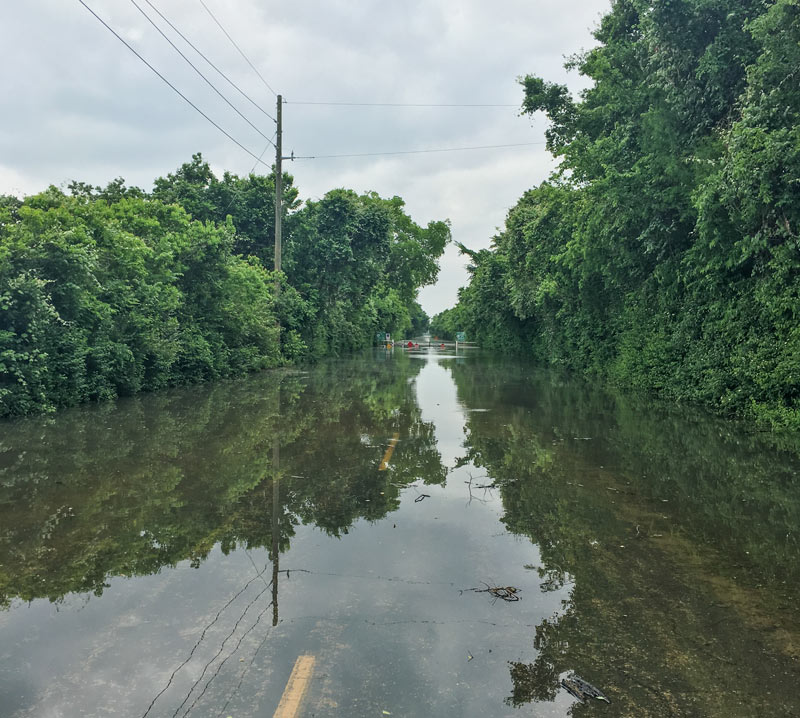
A reader caught the view above during a lunchtime bike ride into the Barker reservoir yesterday. The shot shows the nearly submerged stop signs on the currently-closed road barricade where Barker Clodine Rd. merges into the hike-and-bike trail system running throughout much of the reservoir (which stretches between I-10 and the Westpark Tollway just west of Hwy. 6). The Corps of Engineers has been releasing water from both Barker dam and its sister reservoir Addicks across I-10 since Thursday — but the level behind the dams continued to rise for a few days as additional water drained into the basins from the surrounding watersheds, faster than that water could be safely released downstream into Buffalo Bayou.
Both Barker and Addicks reservoirs’ levels finally began dropping on Saturday — though both started filling again briefly on Sunday as water from later-in-the-week storms trickled east from the surrounding watersheds. Below is an up-to-date look at Barker reservoir’s change in storage since the Tax Day flood, per USGS measurements:
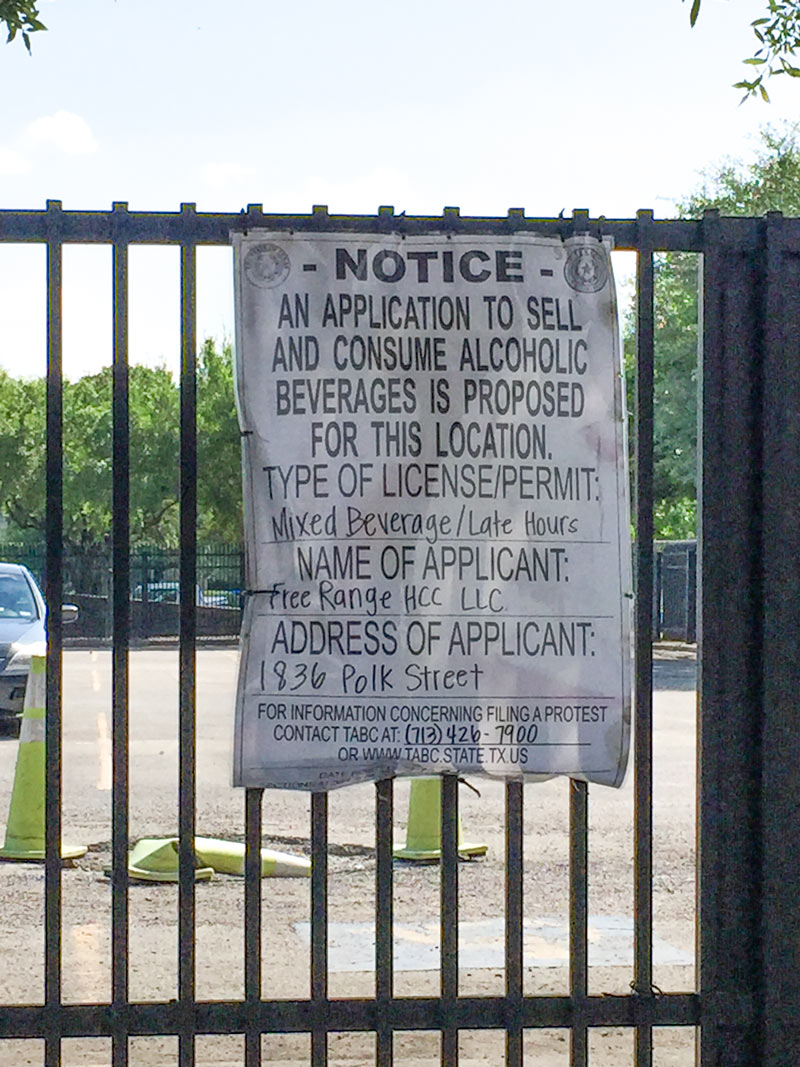
A sign zip-tied onto the fence around the parking lot at 1836 Polk St. is currently announcing an application by FreeRange Concepts to sell mixed drinks at the spot.  Up in Dallas, the company operates bar-slash-bowling alley Bowl & Barrel, bar-slash-dogpark Mutts Canine Cantina, restaurant-slash-music-venue The Rustic, and slashless restaurant The General Public. Houston locations of Bowl & Barrel and The General Public are currently under construction in CityCentre.
It’s unclear whether FreeRange has cast the Polk location for a sequel to one of its existing brands, or for something new. The TABC notice is posted on the full-block parking lot bounded by Jackson, Hamilton, and Bell streets just east of 59 and just south of the George R. Brown Convention Center. That block has previously appeared in the convention center’s 2025 Master Plan, as a site of possible future expansion:
